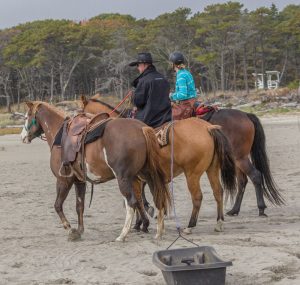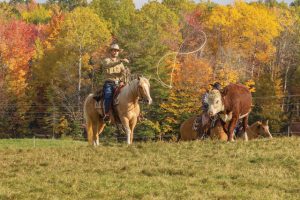Story and photos by Kim Stone
This article originally appeared in issue No.110
Crisp air, clear blue skies, brilliant gold, red, orange and yellow leaves cloaked the trees outlining the lush green pastures at Shinanatu Farm, in Brunswick, Maine. A buzz of excitement filled the air as participants from all over New England settled their horses into paddocks in preparation to work with Martin Black.

Martin Black’s annual trip to Maine offers a diverse learning environment for horse enthusiasts of all disciplines. Riders have opportunities to explore horsemanship through private lessons, riding the trails, obstacle work, stockmanship, roping, and riding on the beach. Participating in one of these non-traditional clinics requires flexibility, gumption, and the ability to ride outside an arena, using natural landscapes in an unstructured setting that will challenge and improve even the most experienced rider.
Martin travels to most of his clinics without his own horses, using horses and tack that are available to him wherever he goes; the same is true for Maine. It is fascinating, intriguing, and often down right impressive to watch him ride unfamiliar horses – asking them to do jobs they aren’t familiar with, getting the job done, and allowing both the horse and participants to learn from the situation.
Do you ask “the hard questions”? “Do you know what to do when things get fast”? “What is your go-to position when your horse begins to make decisions for the both of you”? Riders learn to answer these questions in many different situations. Riding out in open areas or through narrow tree-lined trails, loping, hill work, bridges, gullies, ditches, and deep mud, brings out the best, and sometimes the worst, in both riders and horses. Horses crowding others on the trail, horses refusing to go forward, bunching up, creating anxious, stomping, spring-loaded feet, for fear of missing out. As the rider of the horse, you are responsible for your horse, where the feet, the head, and the tail go. Martin offers guidance: using the horse’s energy to your advantage, teaching from life experiences, in real-time situations, learning through experience – aka, out of your comfort zone. “There is no growth in the comfort zone; there is no comfort in the growth zone.”

The clinic is separated into 3 sessions: Private lessons, a 4-day horsemanship/stockmanship clinic, and a Surf, Sand and Suppleness clinic at Popham Beach. Beginning with private lessons, riders work one-on-one with Martin. This personal time allows for an “anything goes” session: ground-work, rope handling, green horse handling, lead changes, bridling, working with a saddle-sour horse, trailer loading, fresh horses, separation anxieties, preparing your horse for a safe ride—all of these important lessons took place this year.
The extensive 4-day clinic mixes stockmanship, horsemanship, small group work, and group meetings each day. These unique dynamics present participants time to learn how he/she might be able to offer the horse something different. A briefing, of the what is to come, and a review of what “just happened.” Four full days, both in the classroom and with practical experience while riding out in open areas, along the trail, working cattle in open fields, sets the foundations to go deeper for both horse and rider.
Day 1

Introductions, Martin takes the time to get to know each participant and what they hope to gain from the clinic during the morning meeting. Horses are saddled, riders are ready.We begin in a large grass pasture, together, understanding the importance of footfall, rating, keeping the same distance between horses in front and behind us before heading down the wooded trail. Nestled deep in the woods is the Birches Arena, an open sand arena that relies on natural embankments, trees, and hills as a fence. Martin’s “Equitation Foundation” is practiced here, moving the shoulders and hindquarters forward and back around both the front and back feet independently. In total, there are eight foundational maneuvers. Clear, precise communication.
Day 2
Morning briefing, notebooks in hand, questions asked and discussed, a quick introduction to handling cattle before we saddle up to work on our Stockmanship. The cattle typically only see a dog and one handler through out the year, which often creates curious, fresh cattle, greeting nervous, charged-up riders and horses. Cattle wanting to sniff incoming horses creates a crystal-clear introduction to understanding the flight zone and balance point. A single-line electric fence suggests a boundary. When crossed, as if a line drawn in the sand, fencing goes zinging into the herd, scattering horses and cattle to scatter like bowling pins. Learning to work together is essential to gathering the herd, while presenting a positive experience for both young and seasoned horses and riders. Fencing will not hold the cattle; horses and riders do.
Day 3

Revisiting the importance of separating all four quarters of your horse in relation to handling cattle during the morning briefing. As the weather is unpredictable, horses were loaded up to work at an indoor arena. Tight quarters, nail tapping rain on the metal roof, the switch from riding in large open areas and working cattle, required even more adjustments. The attention and value of rating your horses, speed, slowing down, moving over, using the 8 maneuvers of Martin’s Equitation Foundation, to achieve better feel, timing and rhythm with the confines of limited space.
As with all of the clinics here in Maine, Martin is willing to probe into horse behavior at any level of learning. Participants were invited to watch as he worked two young BLM Mustangs. In his quiet way, within minutes, each Mustang began to experience the comfort of a gentle rub, the guided experience of being led from a saddle horse, the importance of yielding their hind-quarters and unsticking their feet to find comfort. The changes took place between blinking and footfalls, a quick study showing how feel and timing are essential to building confident, curious, respectful horses. His next project was a rank, puffed up, young stud colt, which had become dangerous to both handlers and other horses. Working from his saddle horse, Martin provided a few key points of communication and guidelines. The colt quickly began to respect both the saddle horse and Martin’s offerings for a better deal. In true fashion, Martin reaches easily into his bottomless tool box of life experiences to aid in helping horses become better partners.
Day 4

Returning to cattle work with fine-tuned horses, riders worked together gathering the cattle seamlessly – a big change from our first day. Riders begin to feel(rather than intellectually know) the importance of pressure and relief, while containing them in rodear style in the middle of the pasture. Quiet footfall, mixed with spurts of quick speed and stealth, was necessary to keep the herd within the suggested area. “What would you like to do with the herd today”? Each rider took a turn working the cattle, and the options were many: sort, take two, or more, away from the herd, keeping them separated for a full rotation, roping, divide the cattle into two different herds, sort the reds from the blacks… each rider needed to execute the task, with Martin coaching from the sidelines and offering guidance. Riders holding the rodear were responsible for not letting any cattle “out” or past their horses. Each rider was responsible from stirrup to stirrup to close the gap, to not allow cattle to squeeze out of the designated holding area.
Transition moments between morning meetings, lunch, and switching horses, created unlimited opportunities in handling horses in everyday situations. Rodeo moments, hobbling, hackamore introductions, two-rein experience, and doctoring a severely wounded horse are a few noteworthy mentions.
The last clinic of each year is the Surf, Sand and Suppleness clinic. It’s a day to enjoy riding along one of the most beautiful beaches in Maine, with great friends, and fun horses, while learning from Martin. He teaches the benefits of fresh sand, pattern making, crashing waves, rope handling, dragging a sled, riding into the water, ponying, transitioning from a walk to a lope and back again.
In summary, a great clinic consists of people encouraging each other, being flexible, willing to do something out of the norm, finding comfort in the uncomfortable, a teacher who listens, demonstrating real-time situations with out-of-the-box of thinking, searching for the root cause within any given problem. Fixing-it-up to find comfort, allowing soak time, and a kind word builds confidence in both horse and rider. Martin encourages riders to get out of the comfort zone, to try new things, even if you don’t feel ready. His clinics in Maine fill quickly each year offering a diverse environment for endless possibilities.
Check Martin Black’s web site for all clinic options.
Subscribe today for more helpful horsemanship articles.
[ux_custom_products cat=”magazine-subscriptions” products=”” columns=”4″ title=””]


